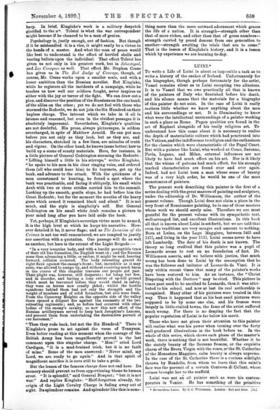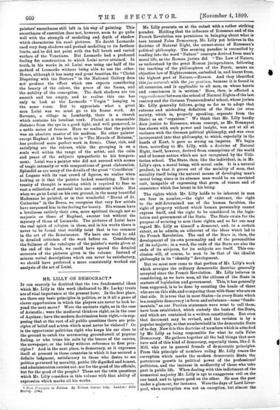To write a Life of Luini is about as impossible
a task as to write a history of the snakes of Ireland. Unfortunately for the biographer, though perhaps fortunately for the artist, Vaaari remains silent as to Luini excepting two allusions. It is to Vasari that we owe practically all that is known of the painters of Italy who flourished before his death, and his silence means that the materials for a biography of this painter do not exist. In the case of Luini it really matters little whether we know anything about the man and his surroundings or not. It is illuminating to know what were the intellectual surroundings of a painter working in such a place as Rome. Pagan qualities are found in the art• of Raphael alongside of his really religious art. To understand how this came about it is necessary to realise the depth of materialistic culture which had penetrated into the Vatican, and the indifference to religion and the enthusiasm for the classics which were characteristic of the Papal Court. But with a painter like Luini, who worked at Como, Saronno, Pavia, Lugano, and Milan, external influences are not likely to have had much effect on his art. Nor is it likely that the whims of patrons had much effect, for his strongly marked characteristics are found over and over again. Indeed, had not Luini been a man whose sense of beauty was of a very high order, he would be one of the most monotonous of painters.
The present work describing this painter is the first of a series dealing with the great masters of painting and sculpture, under the editorship of Dr. Williamson, the author of the present volume. Though Luini does not claim a place in the very front of Renaissance painting, he is one of those masters whose work we should sorely miss. Therefore we are most grateful for the present volume with its sympathetic text, well-arranged list, and excellent illustrations. In this book all that is known about Luini is set forth, but we are told that even the traditions are very meagre and amount to nothing. Born at Luino, on the Lago Maggiore, between 1465 and 1475, and living in the year 1533, Lnini seems never to have left Lombardy. The date of his death is not known. The theory so long credited that this painter was a pupil of Leonardo seems to rest on no foundation of fact. Dr. Williamson asserts, and we believe with justice, that much wrong has been done to Luini by the assumption that he was the follower and imitator of Leonardo da Vinci. It is only within recent times that many of the painter's works have been restored to him. As an instance, the " Christ Disputing with the Doctors " may be cited. This picture in times past used to be ascribed to Leonardo, then it was attri- buted to his school, and now at last its real authorship is recognised. Many other of his pictures were treated in this way. Thus it happened that as his best easel pictures were supposed to be by some one else, and his frescos were largely in little-visited towns, the fame of the artist suffered much wrong. For there is no denying the fact that the popular reputation of Luini is far below his merit.
Those who have not given their attention to this painter will realise what was his power when turning over the forty well-produced illustrations in the book before us. In the whole of this series, which shows each phase of the master's work, there is nothing that is not beautiful. Whether it be the stately beauty of the Saronno frescos, or the exquisite charm of the Brera Virgin with the roses, or the St. Catherine of the Monastero Maggiore, calm beauty is always supreme. In the case of the St. Catherine there is a curious sidelight thrown by Bandello, from whom we learn that this saint's face was the portrait of a certain Contessa di Cellant, whose crimes brought her to the scaffold.
Luini was not an oil painter such as were his contem- poraries in Venice. He has something of the primitive
• Bernardino Luing. By G. C. Williamson. London : Bell and Sons. [38.)
painters' smoothness still left in his way of painting. This smoothness of execution does not, however, seem to go quite well with the strength of modelling and depth of shadow which characterise his easel pictures. No doubt Leonardo used very deep shadows and pushed modelling to its farthest limits, and be did not paint with the fall brush and varied surface of the Venetians. But Leonardo had a profound feeling for construction to which Luini never attained. In truth, in his works in oil Luini was using one half of the method of Leonardo without being able to use the other. Hence, although it has many and great beauties, the "Christ Disputing with the Doctors" in the National Gallery does not produce the effect which one expects considering the beauty of the colour, the grace of the forms, and the nobility of the conception. The dark shadows are too smooth and too empty, and to realise this one has only to look at the Leonardo " Virgin " hanging in the same room. Bat to appreciate what a great man Lnini was we must go to his fresco work. At Saronno, a village in Lombardy, there is a church which contains his loveliest work. Placed at a reasonable distance from the eye in a good light, and well preserved, is a noble series of frescos. Here we realise that the painter was an absolute master of his medium. No other painter except Raphael at his best, as in " The Miracle of Bolsena," has produced more perfect work in fresco. Clear, rich, and satisfying are the colours, while the grouping is on a scale well within the range of the artist, and the calm and peace of the subjects sympathetic to his tempera- ment. Luini was a painter who did not succeed with scenes of tragic intensity or with compositions of great elaboration. Splendid as are many of the details of the great "Crucifixion" at Lugano with its vast crowd of figures, we realise when looking at it that the painter lacked something. That in- tensity of thought is wanting which is required to fuse so vast a collection of material into one consistent whole. But when we go to Luini on his own ground, in the many beautiful Madonnas he painted, or in that wonderful "Burial of St. Catherine" in the Brera, we recognise that very few artists have surpassed him in the feeling for beauty. His women have a loveliness entirely their own, more spiritual though not so majestic as those of Raphael, sweeter but without the mystery of those of Leonardo. The pictures of Luini have the real spirit of religion in them, and in his works there is never to be found that worldly taint that is too common in the art of the Renaissance. Ws have one word to add in detailed criticism of the work before us. Considering the fullness of the catalogue of the painter's works given at the end of the book, we could have spared the detailed accounts of the pictures given in the volume. Instead of minute verbal descriptions which can never be satisfactory, we should have preferred a more consistently worked out analysis of the art of Luini.























































 Previous page
Previous page